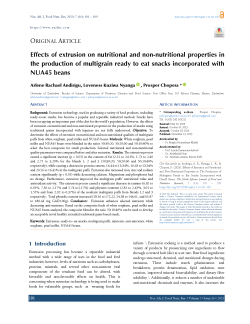Effects of extrusion on nutritional and non-nutritional properties in the production of multigrain ready to eat snacks incorporated with NUA45 beans
Abstract
Background: Extrusion technology, used in producing a variety of food products, including ready-to-eat snacks, has become a popular and reputable industrial method. Snacks have been occupying an important part of the diet for the world's population. However, the effects of extrusion on nutritional and non-nutritional properties in the production of snacks using traditional grains incorporated with legumes are not fully understood. Objective: To determine the effects of extrusion on nutritional and non-nutritional qualities of multigrain puffs from white sorghum, pearl millet and NUA45 beans. Methods: White sorghum, pearl millet and NUA45 beans were blended in the ratios 50:30:20, 50:20:30 and 50:10:40% to select the best composite for snack production. Selected nutritional and non-nutritional quality parameters were compared before and after extrusion. Results: The extrusion process caused a significant increase (p < 0.05) in the content of fat (2.22 to 2.61%, 1.73 to 2.40 and 2.75 to 3.29% for the blends 1, 2 and 3 (50:30:20, 50:20:30 and 50:10:40% respectively), while causing a decrease in protein content, 14.44 to 13.34%, 16.63 to 13.34% and 20.56 to 16.41% in the multigrain puffs. Extrusion also increased iron, zinc and sodium content significantly (p < 0.05) while decreasing calcium. Magnesium and phosphorus had no change. Furthermore, extrusion improved the multigrain puffs' nutritional value and antioxidant activity. The extrusion process caused a significant decrease in tannins (6.82 to 6.01%, 7.82 to 2.17% and 5.74 to1.17%) and phytates contents (2.82 to 2.43%, 3.01 to 1.55% and from 2.92 to 0.37%) of the resultant multigrain puffs from blends 1,2 and 3 respectively. Total phenolic content increased (18.56 to 172.22, 24.38 to 144.61, and 65.87 to 180.44 mg GAE/100g). Conclusion: Extrusion enhances selected nutrients while decreasing anti-nutrients. Based on the composite feeds of white sorghum, pearl millet and NUA45 beans analyzed, the composite blend in the ratio 50:10:40% can be used to develop an acceptable novel healthy extruded traditional grain-based snack.
Keywords: extrusion, ready-to- eat snacks, multigrain puffs, nutrients, anti-nutrients, white sorghum, pearl millet, NUA45 beans.
Full text article
Authors
Copyright (c) 2023 Arlene Rachel Andirigu, Loveness Kuziwa Nyanga, Prosper Kujinga Chopera

This work is licensed under a Creative Commons Attribution 4.0 International License.
-
Attribution — You must give appropriate credit, provide a link to the license, and indicate if changes were made. You may do so in any reasonable manner, but not in any way that suggests the licensor endorses you or your use.
-
No additional restrictions — You may not apply legal terms or technological measures that legally restrict others from doing anything the license permits.
Article Details
Accepted 2023-10-28
Published 2023-11-13





